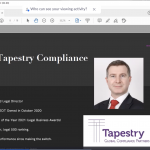AML compliance posts are coming thick and fast.
Is your firm caught by the Money Laundering Regulations? About three quarters of law firms are. Either because they provide a regulated service (e.g. property or other transactional work) or fall into the sneaky definition of ‘tax adviser’ or ‘trust and company service provider’.
(If you don’t know whether you are caught, you absolutely must check – close this page and do it now!)
If the answer is yes, then you have to screen your employees before they start working for you and on an ongoing basis.
An AML compliance blind spot
If this employee screening duty is news to you, believe me when I say you are not alone.
A recurring theme in our Regulation 21 AML audits is that most firms are in the same boat. They are either completely unaware of the rule or they only undertake screening as part of pre-employment checks. Ongoing screening catches most firms out.
So what is the employee screening rule?
Regulation 21(1) says:
“Where appropriate with regard to the size and nature of its business, a relevant person must…
(b) carry out screening of relevant employees appointed by the relevant person, both before the appointment is made and during the course of the appointment…”
This means you will have to assess whether employee screening is ‘appropriate’ for your business.
May I suggest that it would be a brave law firm to conclude that, even though they are subject to the Money Laundering Regulations, it is not appropriate for them to comply with Regulation 21.
Possibly a one or two person firm could get away with it, or if you only have single digit AML matters.
And even if you did conclude that you are not caught by Regulation 21, you should definitely record why you came to that conclusion. For self-preservation more than anything.
What is a ‘relevant employee’ under Regulation 21?
Not everyone in the firm is going to be subject to mandatory screening for AML compliance.
It is only those employees who meet the ‘relevant employee’ definition in Regulation 21(2):
“…(b) a relevant employee is an employee whose work is—
(i) relevant to the relevant person’s compliance with any requirement in these Regulations, or
(ii) otherwise capable of contributing to the—
(aa) identification or mitigation of the risks of money laundering and terrorist financing to which the relevant person’s business is subject, or
(bb) prevention or detection of money laundering and terrorist financing in relation to the relevant person’s business….”
This is a pretty wide definition. It affects anyone with a role to play in the firm’s detection and prevention of money laundering. This is likely to include:
- fee earning staff
- compliance staff and those holding nominated roles (COLP, COFA, MLRO, MLCO)
- ‘onboarding’ teams
- management
- finance teams
There might be others that are relevant in your firm.
‘Employee’ should be interpreted widely – not just those with a strict employment contract. I would include Partners/Directors and possibly consultants if they fit the ‘relevant employee’ definition.
It is more about roles, rather than legal status.
And it does not just apply to lawyers!
How to conduct relevant employee screening for AML compliance
Regulation 21(2) says:
“…(a) “screening” means an assessment of—
(i) the skills, knowledge and expertise of the individual to carry out their functions effectively;
(ii) the conduct and integrity of the individual…”
We could summarise this as the employee’s competence and character.
Here are some ways to screen your employees:
- Training/continuing competence records (have they completed AML training?)
- SRA register
- DBS checks
- Employer references
- Credit checks
- Companies House searches
- Google searches
- Self-declarations as to competence and character
Timing is very important. The screening should take place before the employee starts their role, not in their first week of induction. So give yourself time between job offer and start date to do the necessary checks.
You may also have to factor this into any locum solicitor appointments.
And don’t forget, this is an ongoing requirement. You will need some way of tracking (a) who the ‘relevant employees’ in the business are, and (b) when their screening is due for an update.
P.S. You are doing your AML audits…right?
Regulation 21 of the Money Laundering Regulations is the gift that keeps giving.
As well as screening employees, you will also need to complete an independent audit of your firm’s AML processes and their effectiveness. It’s a big job and can’t be completed by your compliance team, assuming they have an input into the firm’s AML compliance.
Read this post for more details or complete a request for all the free templates you will need to complete your internal audit.








